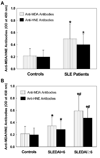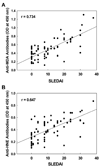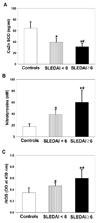Markers of oxidative and nitrosative stress in systemic lupus erythematosus: correlation with disease activity
- PMID: 20201076
- PMCID: PMC2935652
- DOI: 10.1002/art.27442
Markers of oxidative and nitrosative stress in systemic lupus erythematosus: correlation with disease activity
Abstract
Objective: Free radical-mediated reactions have been implicated as contributors in a number of autoimmune diseases, including systemic lupus erythematosus (SLE). However, the potential for oxidative/nitrosative stress to elicit an autoimmune response or to contribute to disease pathogenesis, and thus be useful when determining a prognosis, remains largely unexplored in humans. This study was undertaken to investigate the status and contribution of oxidative/nitrosative stress in patients with SLE.
Methods: Sera from 72 SLE patients with varying levels of disease activity according to the SLE Disease Activity Index (SLEDAI) and 36 age- and sex-matched healthy controls were evaluated for serum levels of oxidative/nitrosative stress markers, including antibodies to malondialdehyde (anti-MDA) protein adducts and to 4-hydroxynonenal (anti-HNE) protein adducts, MDA/HNE protein adducts, superoxide dismutase (SOD), nitrotyrosine (NT), and inducible nitric oxide synthase (iNOS).
Results: Serum analysis showed significantly higher levels of both anti-MDA/anti-HNE protein adduct antibodies and MDA/HNE protein adducts in SLE patients compared with healthy controls. Interestingly, not only was there an increased number of subjects positive for anti-MDA or anti-HNE antibodies, but also the levels of both of these antibodies were statistically significantly higher among SLE patients whose SLEDAI scores were > or = 6 as compared with SLE patients with lower SLEDAI scores (SLEDAI score <6). In addition, a significant correlation was observed between the levels of anti-MDA or anti-HNE antibodies and the SLEDAI score (r = 0.734 and r = 0.647, respectively), suggesting a possible causal relationship between these antibodies and SLE. Furthermore, sera from SLE patients had lower levels of SOD and higher levels of iNOS and NT compared with healthy control sera.
Conclusion: These findings support an association between oxidative/nitrosative stress and SLE. The stronger response observed in serum samples from patients with higher SLEDAI scores suggests that markers of oxidative/nitrosative stress may be useful in evaluating the progression of SLE and in elucidating the mechanisms of disease pathogenesis.
Figures




Comment in
-
Oxidative stress in systemic lupus erythematous: comment on the article by Wang et al.Arthritis Rheum. 2010 Dec;62(12):3835-6. doi: 10.1002/art.27719. Arthritis Rheum. 2010. PMID: 20737468 No abstract available.
Similar articles
-
Significance of Lipid-Derived Reactive Aldehyde-Specific Immune Complexes in Systemic Lupus Erythematosus.PLoS One. 2016 Oct 17;11(10):e0164739. doi: 10.1371/journal.pone.0164739. eCollection 2016. PLoS One. 2016. PMID: 27749917 Free PMC article.
-
Reduction of nitric oxide and DNA/RNA oxidation products are associated with active disease in systemic lupus erythematosus patients.Lupus. 2017 Sep;26(10):1106-1111. doi: 10.1177/0961203317692436. Epub 2017 Mar 22. Lupus. 2017. PMID: 28420072
-
Immunological studies of oxidized superoxide dismutase in patients with systemic lupus erythematosus. Correlation with disease induction and progression.Saudi Med J. 2012 Nov;33(11):1177-84. Saudi Med J. 2012. PMID: 23147873
-
Oxidative stress-related biomarkers in multiple sclerosis: a review.Biomark Med. 2016 Aug;10(8):889-902. doi: 10.2217/bmm-2016-0097. Epub 2016 Jul 14. Biomark Med. 2016. PMID: 27416337 Review.
-
The biology of nitric oxide and other reactive intermediates in systemic lupus erythematosus.Clin Immunol. 2006 Dec;121(3):243-50. doi: 10.1016/j.clim.2006.06.001. Epub 2006 Jul 24. Clin Immunol. 2006. PMID: 16861040 Free PMC article. Review.
Cited by
-
Gut microbiome-host interactions in driving environmental pollutant trichloroethene-mediated autoimmunity.Toxicol Appl Pharmacol. 2021 Aug 1;424:115597. doi: 10.1016/j.taap.2021.115597. Epub 2021 May 27. Toxicol Appl Pharmacol. 2021. PMID: 34051218 Free PMC article.
-
Effects of cystamine on antioxidant activities and regulatory T cells in lupus-prone mice.J Cell Mol Med. 2013 Oct;17(10):1308-15. doi: 10.1111/jcmm.12107. Epub 2013 Aug 2. J Cell Mol Med. 2013. PMID: 23905628 Free PMC article.
-
Increased 8-hydroxy-2'-deoxyguanosine in plasma and decreased mRNA expression of human 8-oxoguanine DNA glycosylase 1, anti-oxidant enzymes, mitochondrial biogenesis-related proteins and glycolytic enzymes in leucocytes in patients with systemic lupus erythematosus.Clin Exp Immunol. 2014 Apr;176(1):66-77. doi: 10.1111/cei.12256. Clin Exp Immunol. 2014. PMID: 24345202 Free PMC article.
-
Environmental Agents, Oxidative Stress and Autoimmunity.Curr Opin Toxicol. 2018 Feb;7:22-27. doi: 10.1016/j.cotox.2017.10.012. Epub 2017 Oct 26. Curr Opin Toxicol. 2018. PMID: 29532040 Free PMC article.
-
Air pollution, oxidative stress, and exacerbation of autoimmune diseases.Cent Eur J Immunol. 2017;42(3):305-312. doi: 10.5114/ceji.2017.70975. Epub 2017 Oct 30. Cent Eur J Immunol. 2017. PMID: 29204097 Free PMC article. Review.
References
-
- Danchenko N, Satia JA, Anthony MS. Epidemiology of systemic lupus erythematosus: a comparison of worldwide disease burden. Lupus. 2006;15:308–318. - PubMed
-
- Kurien BT, Hensley K, Bachmann M, Scofield RH. Oxidatively modified autoantigens in autoimmune diseases. Free Radic Biol Med. 2006;41:549–556. - PubMed
-
- Frostegard J, Svenungsson E, Wu R, Gunnarsson I, Lundberg IE, Klareskog L, et al. Lipid peroxidation is enhanced in patients with systemic lupus erythematosus and is associated with arterial and renal disease manifestations. Arthritis Rheum. 2005;52:192–200. - PubMed
-
- Khan MF, Wu X, Ansari GA. Anti-malondialdehyde antibodies in MRL+/+ mice treated with trichloroethene and dichloroacetyl chloride: possible role of lipid peroxidation in autoimmunity. Toxicol Appl Pharmacol. 2001;170:88–92. - PubMed
Publication types
MeSH terms
Substances
Grants and funding
LinkOut - more resources
Full Text Sources
Other Literature Sources
Medical
Research Materials

